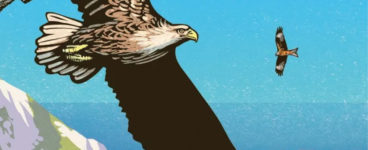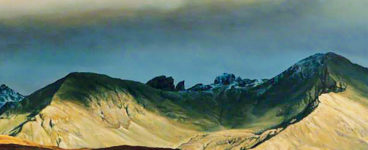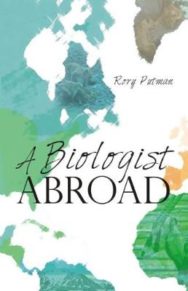‘No written description can really do it justice: the noise, the power and the spray of it.’
A professional biologist with wide experience of working both in the UK and overseas, Rory Putman takes us with him on working trips to Iceland, East Africa, Nigeria and Indonesia, introducing us to the countries and their people, their natural history, and explaining some of the wildlife issues which have prompted himself and his colleagues to travel there in the first place. The stories cover episodes from more than four decades of working as a jobbing biologist overseas. Here, he visits the other worldly landscapes of Iceland.
Extract taken from A Biologist Abroad
By Rory Putman
Published by Whittles
We had hired a big, four-wheel-drive bus to haul us out along the tourist road to Gullfoss and on up into the central highlands. We were to be working in the Þjórsárver, a big water meadow some 20 miles across, tucked neatly beneath the Hofsjökull (High Glacier) on the central massif. The vast meadow of sphagnum and sedge, crisscrossed with streams springing from the glacier, is the main breeding site of the Icelandic pinkfoot – it was here, too, that earlier expeditions, such as that run by Sir Peter Scott and James Fisher in 1952, had come to work on the birds. But now it looked as if we might not make it. The phlegmatic Jonasson was not prepared to take us in. The thaw, it seemed, had been late this year, and although the roads were now clear of snow the route was still in the grip of permafrost. That is to say that the gravel or moraines beneath the track were still frozen solid, but pressure from the weight of a vehicle would cause it to melt and mire the vehicle concerned. The most Jonasson could offer was to take us up part way, to another site, and then come out again later to collect us and take us on into the Þjórsárver. And it would cost us the double trip. Seething with frustration, we had little choice but to agree. Time was short, for the Icelandic summer is a brief one and the snows would be in again by mid-September. So we accepted the inevitable and settled to the task of sorting through all our supplies to break them into two lots: sorting out sufficient food and essential equipment to last us the first few weeks before we could press on to the Þjórsárver itself. A night in the excellent campsite in Reykjavík – and an early start. Our change of schedule meant that we would head for a little place called Fossrófulækur: a ford across a stream some 30 miles short of the Þjórsárver, and safe on the eastern side of the Kerlingarfjöll mountains. Although the place is graced with a name, there is no permanent settlement; indeed, it is little more than a name on a map. A solitary hut stands on the stream bank and marks it as a posting point. A short way further down the stream, the water plunges into a steep and narrow gorge. Along the top of this gorge, on the basalt stacks which tower above the water, a small group of pinkfeet nest – outliers to the main population in the Þjórsárver. It would be worth a look and if nothing else, would serve for us to start to get the feel of things. At all events it would be better than kicking our heels in Reykjavík, despite the hospitable reputation of the Icelandic girls.
Jonasson drove the big four-wheel-drive bus himself. Perhaps feeling slightly sorry for us, he’d brought along one of his tourist ‘guides’ for the trip. A pity that neither of them spoke much English, but the trip itself was compensation enough. We rolled out of Reykjavík and off the tarmac. Past Geysir – perhaps the best-known of Iceland’s attractions for tourists, yet in reality, something of an anticlimax: a few desultory steam spouts hissing away behind a barbed-wire fence. The Great Geysir, which used to erupt every so often with a jet of steam hundreds of feet high, was dead now: throttled with the tons of detergent poured into it over the years to make it oblige. Houses thinned; we had left the last major township behind at Hveragerði of the heated greenhouses. For the most part now, the bus wound over bare rock or hard-packed soil surrounded by desolate bog-meadows or deserts of dry lava. Redshanks and whimbrel called from the lonely landscape; blacktailed godwits, ringed plovers and ptarmigan scattered from in front of our wheels until we pulled off the road mid-morning at the head of the Gullfoss, Iceland’s Golden Waterfall.
Gullfoss is justly reputed to be one of the most beautiful waterfalls in the world. The waters of the Hvítá, gathered together from a myriad of little glacial meltstreams from under the Hofsjökull glacier – from the very meadows in which we were to be working – plunge steeply through a narrow gorge, crashing 160 feet in a double span. The top ‘flight’ of the fall is impressive enough as one stands above it gazing nervously down, but its lower leap into a deep chasm is spectacular in the extreme – throwing rainbows into its spray which reaches up 100 feet or more. It is remarkable that one could then approach right up to it: to stand just above or right below. No written description can really do it justice: the noise, the power and the spray of it.
Jonasson had clearly been disturbed that we had come to Iceland merely to work. Satisfied now that he had shown us at least something of the island’s stark beauty, he started the bus and prepared to move on. The tourist route stops at Gullfoss. Even the hard-packed soil which in those days made pretence of a road this far went no further. From here on across the central plateau to Varmahlið and Akureyri in the north, the trail is marked clearly only on the map.
Jonasson pulled out his two-way radio and kept in constant touch with other vehicles along the route, checking on the weather and road conditions ahead. Every few miles we would lurch to a halt and, despite the language barrier, we soon cottoned on to the routine as we dug out the bogged wheels or threw heavy lava boulders into the ruts ahead so that the bus could crawl forward once more. These road-making stops became a regular feature of the next 60 miles, and we soon became used to piling out of the bus to reduce its weight as we teetered over flimsy suspension bridges. We didn’t mind at all: we were revelling in the desolation and the birdlife.
We crawled steadily onwards; now even the bridges failed: the cost of throwing bridges across the many rivers had dictated to a country with little money that they were to be built only on routes with regular or heavy traffic. On roads in the interior, a span was bridged only for passing a very deep gorge or an impassable torrent. The remainder were forded. But even these were not fords as we knew them: there was no concrete base, and a vehicle had to pick its way across the shifting boulders of the natural stream bed. Further, the Icelanders’ definition of a torrent is not the same as ours, and many of the ‘fords’ crossed raging waters so deep and so fast that we occasionally spied family saloons literally afloat in the race and only disgorged on the opposite bank some considerable distance downstream. Indeed this was apparently the norm, the expected; so much so that the roads on either side of such a stream are deliberately set askew from each other to allow for this same drift.
More birds: harlequin ducks now, golden plovers wheeling above the meadows, ptarmigan – Iceland’s only gamebird – and merlins. Still, everywhere, whimbrel and the little red-necked phalaropes. And our first view ashore of a glacier: one of the outfalls of the Langjökull, brooding, distant and terribly grey, at the far end of Hvítavatn. The whole landscape, grey and desolate: a true desert of volcanic sputum, wild and incredibly vast. And then, as we straightened our backs after another road-mending stop, the sun caught the glistening top of a perfect sugarloaf icecap: the Hofsjökull and the end of our journey. Although Iceland is of sufficiently high latitude that in the summer the sun never truly sets, there is nonetheless an extended twilight period as the sun dips towards the horizon and lifts again. In this red twilight the Hofsjökull looked almost unreal. The last dozen miles seemed to pass in a trance as we dropped down to the ford at Fossrófulækur. This Hofsjökull was to dominate our landscape and our lives for the next 13 weeks as we camped and worked in the meadows at its feet. No matter where we worked or moved, still it was there, watching over us, implacable. But somehow it was more impressive now, at a distance, than when we were close under its shadow or high up on its ice. After we’d pitched the tents, we stood and gazed at it in the dwindling light, poured a solemn libation of good malt whisky to its guardian spirits – and crawled to bed.
A Biologist Abroad by Rory Putman is published by Whittles, priced £16.99.
ALSO IN THIS ISSUE

 David Robinson Reviews: Restoring the Wild
David Robinson Reviews: Restoring the Wild
‘If, in his hero Aldo Leopold’s famous phrase, we ‘think like a mountain’, and realise the interconn …

 The Black Cuillin
The Black Cuillin
‘What is special about the Cuillin is that they are Britain’s only true mountains, comprised of narr …













